Editor’s Introduction
We are republishing this critical analysis of The Times’ December 2023 article “‘Screams Without Words’: How Hamas Weaponized Sexual Violence on Oct. 7." This thorough, thoughtful close reading and the contextualizing remarks that accompany it were collectively produced by the Feminist Solidarity Network for Palestine and offers a masterclass in critically parsing the news.
Since we published this analysis in our fourth print issue in January, no one has been held accountable for The Times’ dangerous propaganda parading as journalism. Indeed, many revelations since then have only made it become a more central image of the critical failures in The Times’ newsroom. After it was revealed that an episode of the newspaper's podcast The Daily centered on the piece was shelved, seemingly because the reporting didn’t hold up to scrutiny, The Times launched an extraordinary, racially targeted witch hunt of the principled journalists responsible for the leaks. It’s also been revealed that "Screams" co-author Anat Schwartz, not a journalist prior to October 7, had liked calls for genocide of the Palestinians on social media and reportedly described her reporting as hasbara, or propaganda for the Israeli government. And, most recently, members of the Kibbutz Be’eri have rejected the claims of sexual assault made in the article.
This is to say that circumstances around “Screams Without Words” have given a rare, unmediated glimpse into The Times’ intransigent commitment to Israeli-American political aims, revealing it to be a deeper-held value to them than any commitment to the truth. Still, the reporting published in The Times is not substantially worse than in most print publications in the United States, it just has a further reach. It takes a critical eye to understand how reporting can be used to frame events, especially in the Middle East. As most pieces of journalism don’t receive as much scrutiny as “Screams Without Words,” it is our hope that the detailed analysis here offers the reader some tools they can apply to any media they consume.
“. . . the fraudulent rape charge stands out as one of the most formidable artifices invented by racism”1
—Angela Y. Davis
EVERYWHERE — As an international collective of feminist academics, writers, and lawyers, we offer the following critical analysis of claims made in The New York Times article “‘Screams Without Words’: How Hamas Weaponized Sexual Violence on Oct. 7,” published December 28, 2023. While this article is presented as the result of an extensive investigation, our research demonstrates that its arguments are not only unfounded, but rely on non-credible witnesses, including unreliable first-responder and IDF testimony. Despite the flimsiness of the given evidence, we debated whether addressing specific claims was the best way to proceed. Before we begin, a few words on why.
What is ‘Screams without Words’ actually attempting to do?
While it claims to be presenting evidence, the article is in fact better understood as aiming to evoke an emotional response in the reader. Professor of criminology Anthony Collins explains that ‘Screams without Words’ belongs to a genre of ‘trauma porn’ which, regardless of factual integrity, is “very socially powerful at triggering not only emotional responses in individuals but collective social responses with social consequences.”2 By dwelling on the most explicit and gruesome details offered in testimonies regarding the alleged atrocities of October 7’s Al-Aqsa Flood, while deliberately refusing to situate the actions of the Palestinian resistance within any political or historical context, the article aims to trigger an overwhelming affective response in the reader (disgust, revulsion, fear, rage). Met with an informational void, the average Times reader will seize upon already available narratives to make sense of this response. The most obvious of these is the myth of the Black/Brown rapist. As scholars of History, Philosophy, Politics and Literature, we know that colonized and racialized men have long been depicted in western cultural production as hypersexual, brutish threats to the ‘purity’ of white/colonial women, and that this narrative has repeatedly served as a means of justifying and enabling racial/colonial violence.
Any extreme of retaliatory violence — or so the story goes — is justified when presented as in defense white/colonial women’s ‘purity’. Taking this history seriously means that the demand to “believe women” qua women cannot be embraced unconditionally or uncritically without an intersectional understanding of colonial/racial power. This is especially important when the demand is weaponized by an oppressive state to silence dissent and to perpetuate the dehumanization of a people whom it seeks to subjugate and destroy.
Similar patterns emerge when it comes to western imaginaries of Arabs and Muslims. With the spread of European colonialism, the predatory Arab or Muslim man (often used interchangeably) began to appear as a major figure in western literature and art, shaping the dominant imaginary. This figure was depicted as a hypersexual, despotic and abusive tyrant from whom Muslim/Arab women needed to be rescued. Jean-Jacques Rousseau, for example, depicted ‘The Orient’ as “despotic . . . more virile, jealous and brutishly sensual . . . its men are tyrants.”3 Edward Said explained that in the 19th century European imaginary the Orient “offended sexual propriety; everything about the Orient . . . exuded dangerous sex . . . an excessive ‘freedom of intercourse.’”4 By representing Arab/Muslim men as sexual predators and Arab/Muslim women as endangered, westerners could justify their colonial invasions of Muslim lands as civilizing missions. This narrative, which carries strong emotional weight with material consequences, has resurfaced time and again to justify imperialist violence — most evident in western representations of gender oppression used to justify the U.S. invasions of Afghanistan and Iraq.5 Today, Jasbir Puar argues that the figure of the ‘terrorist’ in the west stands in for what is considered illicit or aberrant sexuality, and so works to define the category of ‘normal’ sexuality.6 Far from being accidental, the twin tropes of the terrorist and the sexual brute operate in tandem to demonize Arab and Muslim men in the public imagination.
That ‘Screams Without Words’ invokes Orientalist cultural tropes that depict the Arab/Muslim male as a terrorist-rapist in order to fuel racial fantasies in the reader is clear. Descriptions of “severed heads” and “slaughter” with knives (beheading and cutting the throat with a knife are common Islamophobic tropes) and acts of extreme psychopathic brutality (“slic[ing] off her breast” with a box cutter and “play[ing]” with it) summon up tropes of native savagery. This reinforces references to Palestinians as “human animals” — most recently by Israeli war minister Yoav Gallant — in order to strip Palestinian resistance fighters of their rational agency and portray them as bloodthirsty and inhuman. We locate such descriptions within a long history of colonial attempts to dehumanize the colonized; as Frantz Fanon wrote in 1961, “the colonist turns the colonized into a kind of quintessence of evil . . . The ‘native’ is declared impervious to ethics, representing not only the absence of values but also the negation of values. He is, dare we say it, the enemy of values.”7 It is this framing that allows The Times to avoid accounting for their decision not to interview a single leader or operative of Hamas (who released a statement denying that their fighters engaged in sexual violence) or any other Palestinian political or military group. Despite representing a clear departure from journalistic standards of neutrality, this omission goes unchecked. Nor do the writers of this article account for the absence of the voices of Palestinians who have been subjected to systematic and well-documented sexual violence by Israeli and Zionist forces for over 75 years.
Deflecting Attention
Thus, the current manufactured outcry by Israel serves to distract attention from the longue durée of Israeli colonial violence — with its reliance on U.S. military, economic and political support. At the time of writing, almost all the population of Gaza has been displaced, over 23,910 Palestinians have been murdered, at least 8,000 are missing under the rubble, tens of thousands are injured, and countless children have been brutalized and orphaned. The media have played a crucial role in reproducing the discourses used to justify and enable racial/colonial violence for centuries. They “inculcate individuals with the values, beliefs, and codes of behavior that will integrate them into the institutional structures of the larger society.”8 Considering the centrality of the Zionist settler colonial project to maintaining U.S. hegemony in the Middle East, it is not surprising that mainstream media invest resources in obscuring the realities of the genocide in Gaza by projecting Israeli violence onto, and scapegoating, its victims. As one of the leading stenographers of U.S. imperialism, The Times has played a crucial role in this effort.
Given this context, further focusing on these claims carries the risk of entrapping us in Israel’s narrative. Indeed, part of the strategy behind the weaponization of sexual assault is to force voices calling for justice for Palestine into a defensive stance and to divert our energy into rebutting individual allegations. Nevertheless, it is clear that painting Hamas fighters and by extension all Palestinian men9 as irreconcilably ‘savage’, ‘evil’ and prone to sexual brutality enlists powerful western cultural tropes, and so demands address. Collective work is needed to dislodge these images, preventing them from snowballing and undermining the global movement in solidarity with Palestine. As anti-racist feminists, and as witnesses to Israel’s unfolding genocide — its targeting of schools, hospitals and communications, its maiming, massacre, and torture of Palestinians, its campaign of mass starvation and disease, its targeted assassination of journalists and academics, its desecration of the dead — we refuse to allow Israel to hide behind the language of gender justice. We call upon feminists worldwide to stand with us in refusing to be silenced by Israel’s racist misappropriation of this language.
While no author can definitively prove the negative — that no single instance of rape was committed by any side on October 7 — what we can and do prove is the following: Firstly, that Israel has lied — repeatedly, shamelessly, and often badly — in its attempt to claim that Hamas or other Palestinian resistance groups carried out a campaign of systematic rape on October 7, and that The Times is complicit in these lies. Secondly, that the central claim of ‘Screams Without Words’ that there was “a broader pattern of gender-based violence on Oct. 7” is unsubstantiated.
I. Analysis
The following close analysis systematically responds to quotations taken directly from The Times article “Screams without Words.” It is intended as a critical tool for the use of feminists and allies seeking to grapple with claims that Hamas, and by extension the Palestinian resistance, used rape as a weapon of war in their October 7 operation Al-Aqsa Flood.
I.1 — Creating the Illusion of Credible Journalism: The NYT Investigation
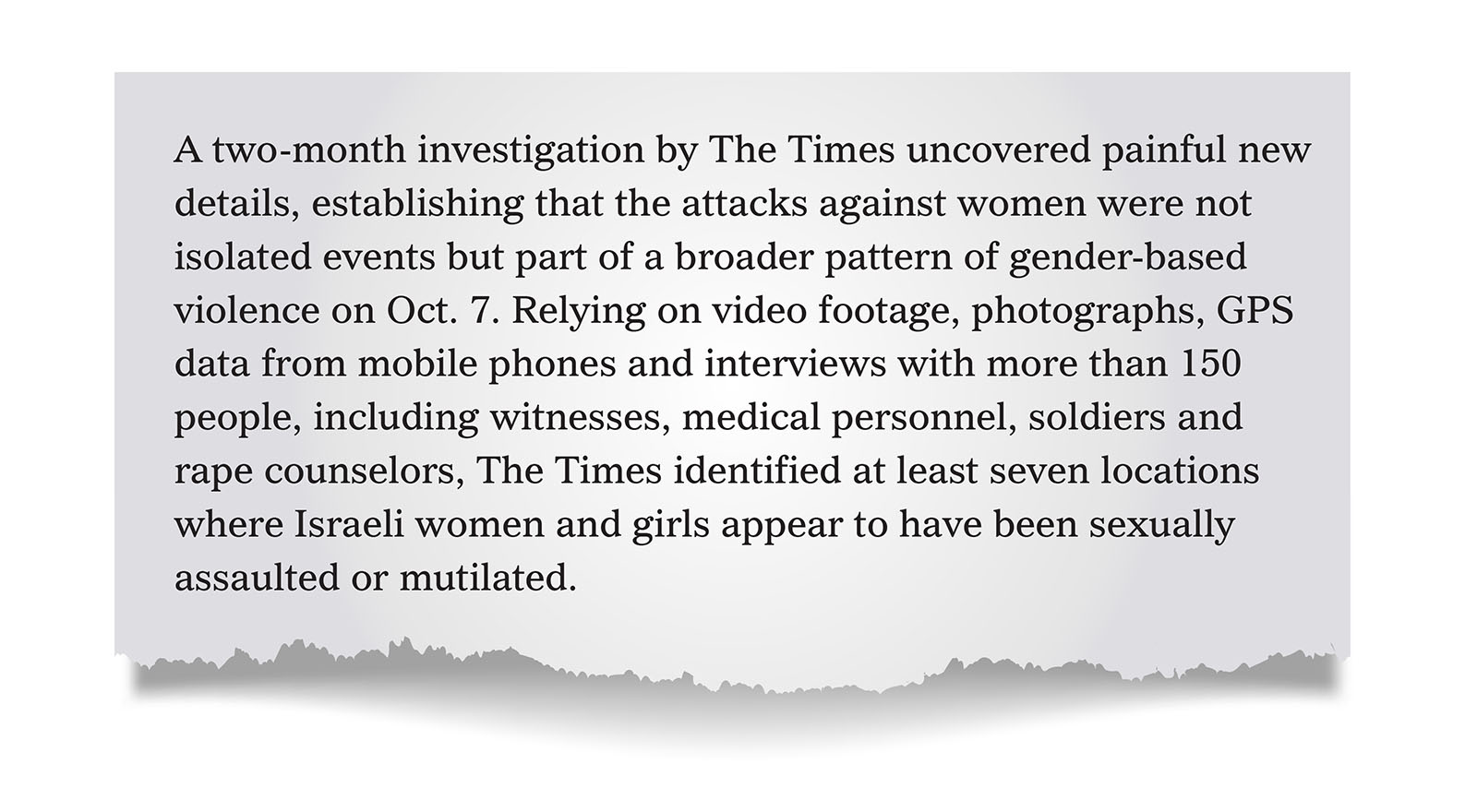
Response
What “new evidence” is presented in ‘Screams Without Words’? The eyewitness testimonies of both Sapir and Raz Cohen are on the public record — already interviewed by police (see hamas-massacre.net, a website set up by the government of Israel) and by news outlets, respectively. The Times conducts longer interviews with each, but the journalists do not appear to have asked probing questions that would establish the credibility of these witnesses. Some “volunteer medics” (ZAKA), an IDF paramedic, and the two IDF reservists at the Shura Military Base have already been interviewed in other media — although the particular ZAKA volunteer whom The Times chooses to focus on is new. Yet, in cases where these “volunteer medics” or soldiers claim to have suspected sexual abuse, no forensic evidence was collected and no autopsies were done. Indeed, there is no forensic evidence, nor any autopsies at all. Arguably, the testimonies that corroborate each of Raz Cohen and Sapir could be construed as “new details,” only if these testimonies withstand scrutiny. We show their weaknesses below.
The Times claims credibility for its investigation from a sheer accumulation of data (which on closer examination proves flimsy), from affective appeal to the singular story of Gal Abdush, and from spectacular and horror-inducing descriptions not only of rape, but of monstrosity, mutilation, and beheading (Islamophobic tropes). In particular, The Times relies heavily on interviews conducted with two categories of witnesses: those claiming to be eyewitnesses of rape (4 in total from two locations at the rave) and witnesses who infer rape by interpreting the positions and states of bodies postmortem.
The Times also claims access to videos and photos (which, except for those claimed to exist on IDF bases, were publicly available prior to the article). Regarding the first category of eyewitness, and despite the lengthy interviews that The Times conducts, their testimonies remain stereotypical and schematically thin. The second category of witness are defined as “medical personnel, soldiers, and rape counselors,” yet on closer examination none cited in the article are professionally trained to determine sexual abuse or rape (see below on ZAKA and the Shura Military Base). More importantly, none of those who say they suspected sexual abuse at the time asked for forensic experts to conduct examinations of the scene or use rape kits on the bodies of potential victims. Anonymous “rape counselors” are only cited to support generic descriptions of the obstacles faced by rape victims in coming forward.

Response
The four witness testimonies cited in ‘Screams Without Words’ all center around the rave (Nova music festival), specifically “two different places along route 232.” The NYT had previously published articles with detailed timelines of events at Kibbutz Be’eri and extensive interviews with survivors from Kfar Aza, in which there was no mention of rape. The paramedic testimony from Kibbutz Be’eri has already been proven to be false (below). The Times does not provide exact details of the testimonies of volunteer medics from Kfar Aza.
The Times seems to be basing much of its argument for a “pattern” of rape on postmortem observations by “soldiers and volunteer medics who together described finding more than 30 bodies of women and girls in and around the rave site and in two kibbutzim.” They infer rape by interpreting the postmortem appearance of the bodies they collected or prepared for burial, not from any medical or forensic examination for which, moreover, they were not trained. Indeed, none of The Times’ sources appear to have requested autopsies or forensic examination for the bodies they claim to have believed were raped. Below, we show why these witness accounts from the Shura Military Base and from volunteer ‘medics’ are to be treated with a great deal of caution.
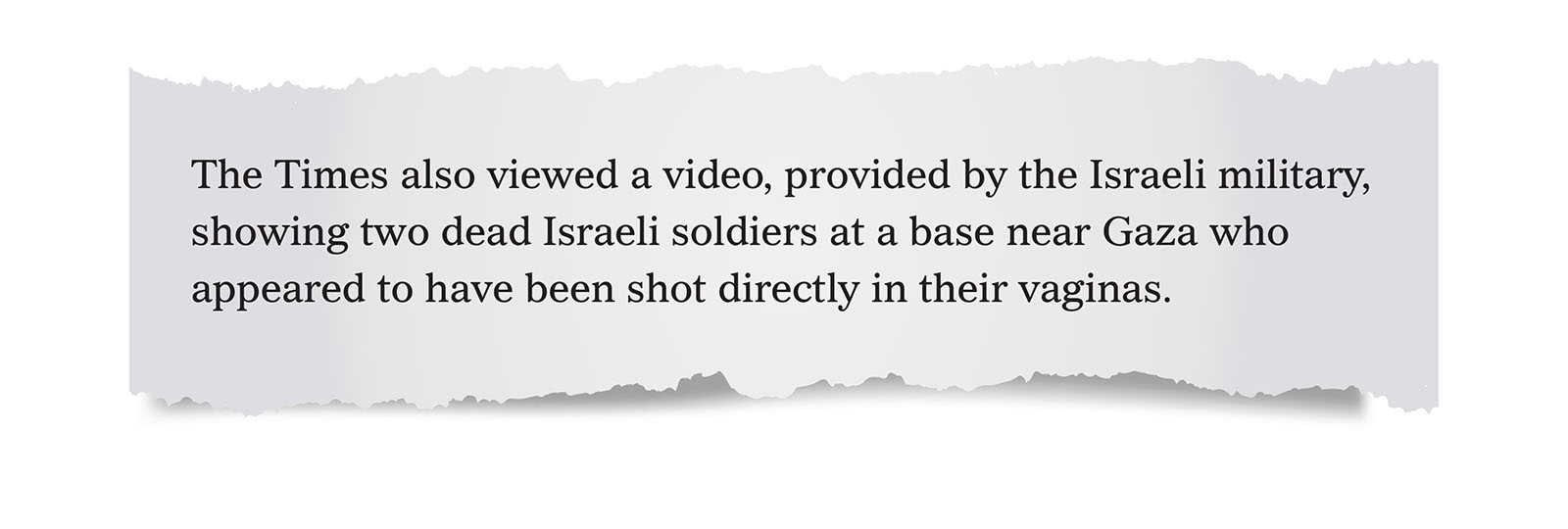
Response
This is an IDF claim that we are asked to take at face value. This video has neither been made public, nor independently verified. We can assume that the journalists shown the video by the Israeli military were not themselves qualified to determine the nature or location of gunshot wounds to a dead body.
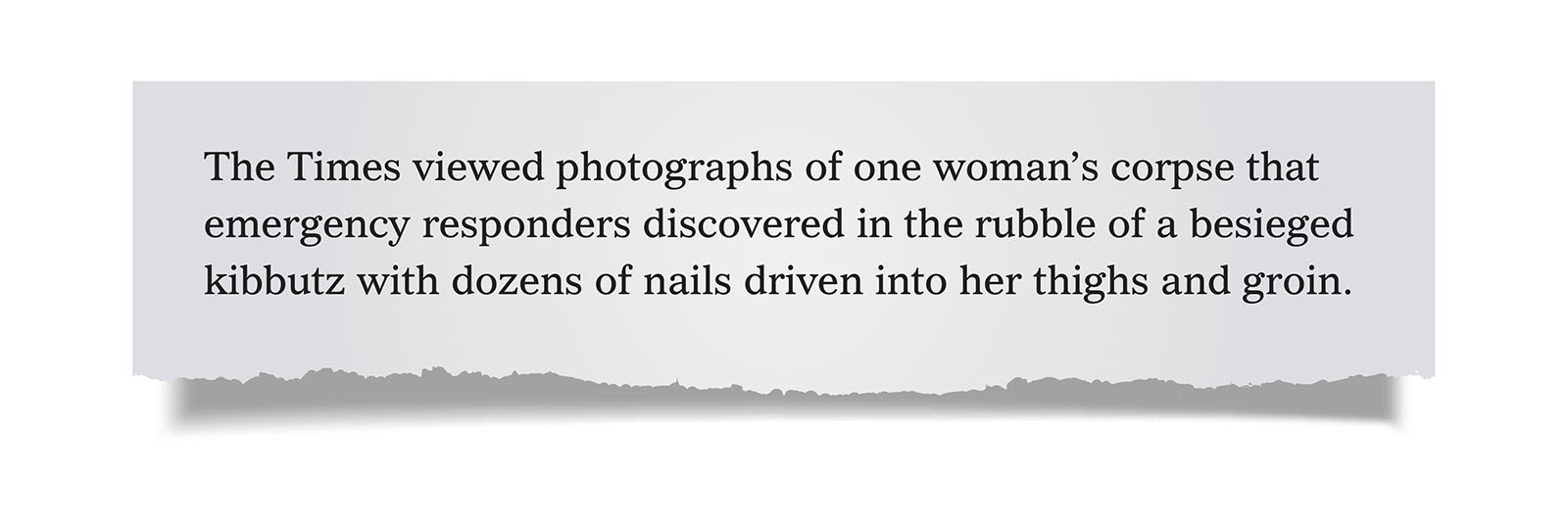
Response
This is a horrible and graphic scene. Does this show a sadistic act of torture, or could the nails have come from the shelling of the house? Hamas and other Palestinian fighters had bullets and hand grenades; while a handful had Rocket Propelled Grenades (RPG), most entering kibbutzim are seen to carry Kalashnikov rifles. Depending on the type, a grenade can create fire and fragmentation, even a hole in a structure. But reducing a house to rubble may indicate, instead, shelling from a tank. It has been established that IDF tanks entered kibbutzim on October 7, including through interviews with tank crews themselves. And there are at least two verified cases in which tanks shelled houses in kibbutzim–houses containing both Israeli settlers and Palestinian fighters. These are also the two kibbutzim where The NYT claims to have found evidence for rape from the postmortem disposition of bodies.
Kibbutz Be’eri
Yasmin Porat, a survivor who had been at the Nova music festival and had taken refuge at Kibbutz Be’eri, recounted in an interview on Israeli State Radio on October 15 that there had been very heavy crossfire (“a gunbattle starts that our police started”) and later “two tank shells were fired into the house.” In a more detailed interview on November 15, Ms. Porat told Israeli Public Broadcaster Kan that she believed everyone in the house was killed when it was shelled by the IDF tank. When she asked why they shelled, the IDF had told her it was “to break the walls in order to help purify the house.” The Times interviewed Ms. Porat and a second survivor, Hadas Dagan, who had been held hostage and was in the garden at the time; they cite Brig. Gen. Barak Hiram as ordering the shelling. Video evidence has surfaced of a tank shelling a house in Kibbutz Be’eri and was shown on Israel’s Channel 12 in December. Families of those killed in the house are seeking an official probe into the events.
Kibbutz Kfar Aza
In an interview on October 14, Lt Col. Golan Vach was asked about the total destruction of burnt-out houses at Kibbutz Kfar Aza. He responded that IDF tanks had to shell houses in order “to conquer back the whole settlement.” (In the house behind him, he noted, 19 Israeli hostages had died.)
I.2 — “The Woman in the Black Dress”: Unpacking the Case at the Center of ‘Screams Without Words’
The Times frames its story around the grainy video of Gal Abdush’s body — a video that was taken on the evening after her death and circulated online — and through a series of interpretative leaps in reading that video. Yet, there is no physical evidence presented to corroborate this interpretation — even though Israeli police are said to have suspected rape when they saw the video and even though Israel made use of the video in its campaign to convince western media to support its genocide in Gaza. The Times was able to gain access to Ms. Abdush’s family and to interview them, on what the family has since claimed were misleading grounds.
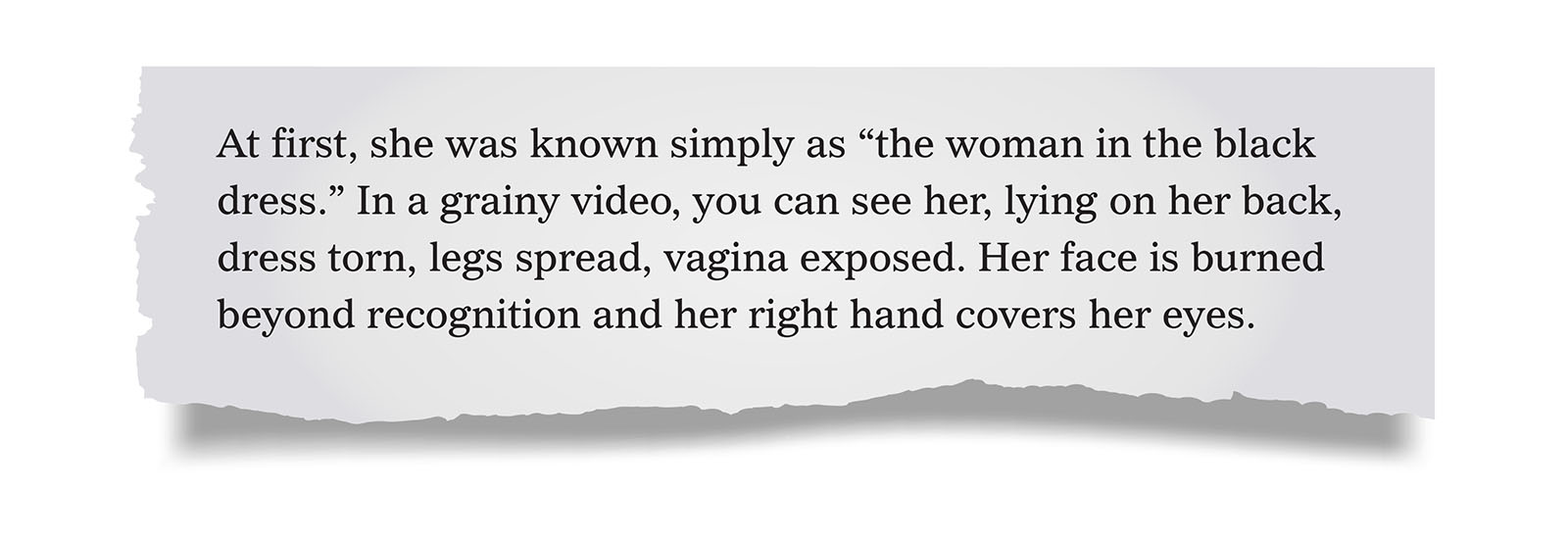
Response
This video of Gal Abdush’s body was filmed by Eden Wessely, as she searched for a friend later on the evening of October 7, and then posted to her Instagram account. It was later posted on hamas-massacre.net, a website set up by the government of Israel. The Times may have focused on this video because it was part of a compiled 43 minute montage shown to select journalists and diplomatic missions by Israel in its campaign to convince western governments to support its genocide in Gaza. However, at least one independent journalist working for The Guardian, who saw that montage, said he did not register seeing evidence of rape.
In interpreting the video, The Times does not consider any of the other possibilities presented by the available information. The position of Gal Abdush’s body and nature of burn injuries could be consistent with Ms. Abdush sitting in a car when it was hit by an air strike from an IDF Apache helicopter (which we know fired on the site of the rave),10 causing her body to fly out of the car. The car could have also been hit by a grenade thrown by a Hamas fighter, or from IDF tank fire, since there is evidence of a tank and an armored vehicle (APV) being on Route 232 with orders to prevent fighters from moving north or returning south.

Response
The Times inadvertently admits, here, that Israel has been weaponizing the image of Ms. Abdush. But its reporters do not bother to inquire why no forensic evidence was collected from the scene or from Ms. Abdush’s remains, given that Israeli officials suspected this to be a case of gender-based violence early on.
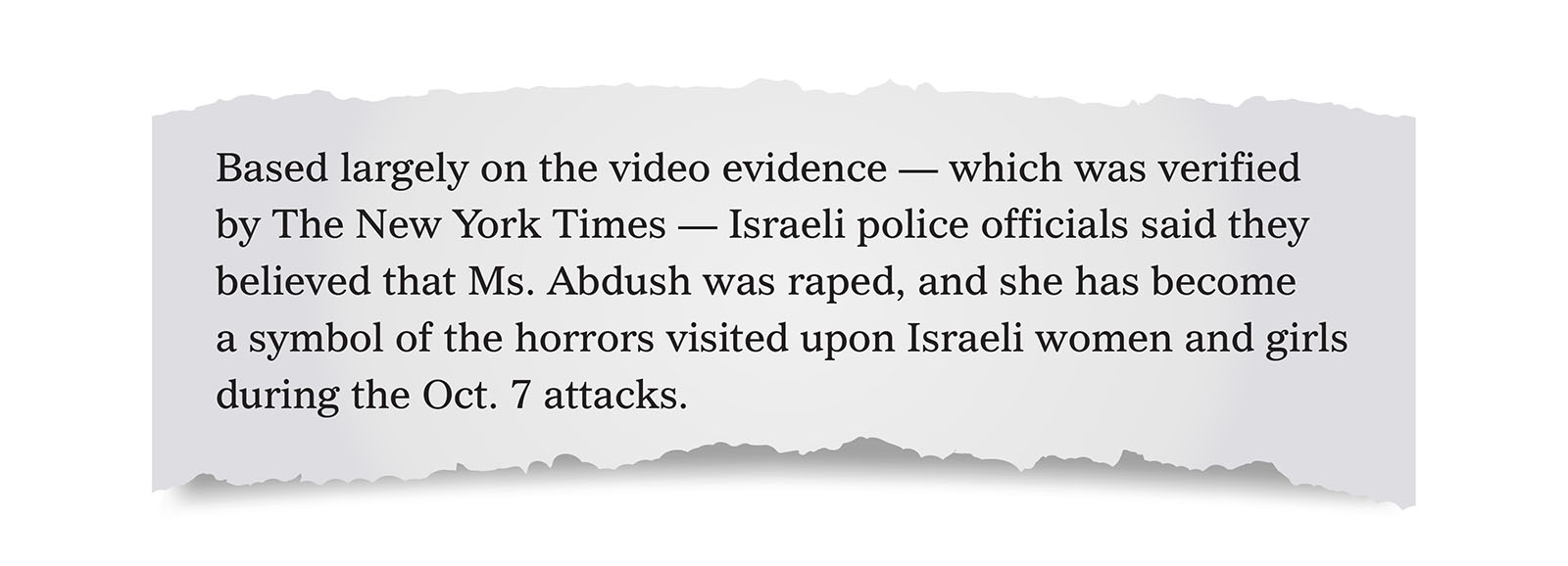
Response
The video being “verified” only means that The Times has determined that the video itself was not doctored. It does not mean that any of the claims being made about the video by Israeli police officials are true. Note that the video was taken postmortem; it is not a video that shows any act of rape or sexual assault. Curiously, Israeli police did not inform Ms. Abdush’s family that they suspected she had been raped, nor did they conduct any forensic examination or an autopsy of the body, either of which should have been possible if, as The Times claims, they suspected rape early on. This seems especially egregious if, as Israeli police now claim, they are having difficulty finding testimonies to substantiate rape on October 7.
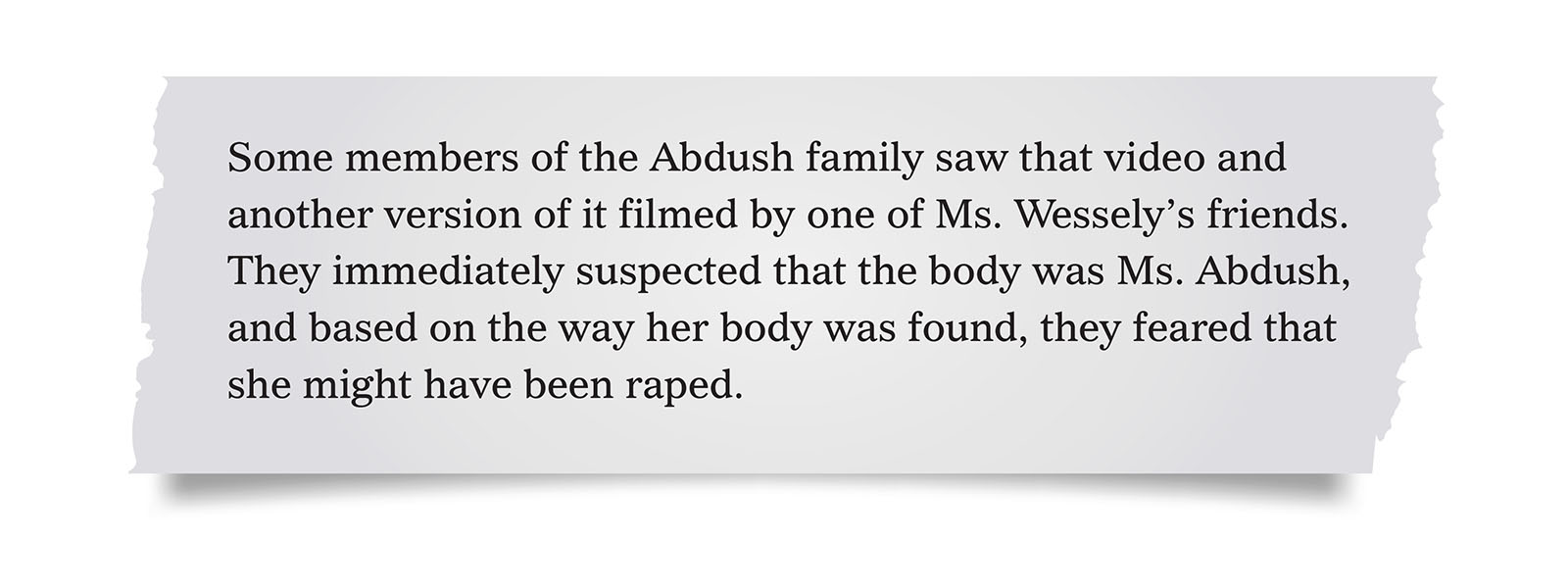
Response
Gal Abdush’s family — shown in the cover image of the article ‘Screams Without Words’ and quoted throughout — have recently stated that they were misled by The Times, who gave them the impression that the article would honor the memory of Gal Abdush and her partner, Nagi Abdush. They did not know that the article would focus on rape. Nor, it appears, had “they feared that she might have been raped” from viewing the video immediately after October 7.
Indeed, Gal Abdush’s mother and brother said they had not suspected rape before they were approached by the journalists from The Times who claimed they had evidence of sexual assault. Her mother, Eti Bracha, told Ynet on December 31, 2023: “We didn’t know about the rape at first, we only knew when The New York Times reporter contacted us. They said they cross-examined the evidence and said that Gal was sexually assaulted. Until now we don’t know what exactly happened.” Her brother said: “It was only in The New York Times investigation that we understood from the journalists that my sister was raped. The feeling was difficult, knowing what she went through.”
Nissim Abdush, Nagi Abdush’s brother, appeared in a 14 minute interview on Israeli Channel 13 on January 1, 2024, in which he repeatedly denied that Gal Abdush had been raped, claiming “the media invented it.” He stated that his brother had called him at 7:00 am, telling him that Gal Abdush had been killed and that he was next to her body. His brother continued to communicate until 7:44 am and, in that time, “never mentioned anything related to sexual assault.” The Times states that Nagi Abdush sent his last message at precisely 7:44 am, asking the family to take care of their children, but fails to mention that he had told his brother that Gal had been shot at 7:00 am or that he never mentioned sexual assault.
Both of Gal Abdush’s sisters also denied that she was raped. According to Mondoweiss, her sister, Tali Barakha, posted on Instagram: “no one can know if there was rape or if she was burned while alive. Have you gone mad? I spoke to Nagi personally! At 7 o’clock, Gal was killed by those animals, and they shot her in the heart. Nagi was alive until quarter past eight. . . .” Indeed, like us when we viewed the video online, several of her family members and friends found that the video “lacks enough information to support the claim of rape.” In an Instagram post on January 2, 2024, Ms. Abdush’s sister, Miral Altar, responded to a video detailing Hamas “sexual atrocities” by Yoseph Haddad (a pro-Israel influencer) saying: “why this story in particular? It’s based on only one video published without the family’s knowledge. . . . It is true that the scenes in the video are not easy, but it’s clear that the dress is lifted upwards and not in its natural state, and half her head is burned because they threw a grenade at the car. I don’t want to be understood as if I’m justifying what they did; they are animals, they raped and beheaded people, but in my sister’s case, this is not true.”
I.3 — Breaking Down Eyewitness Testimonies: Four Witnesses at Two Locations Near the Nova Music Festival
![Pull quote:
Sapir, a 24-year-old accountant, has become one of the Israeli police’s key witnesses. She does not want to be fully identified [...] She also spoke to The Times. In a two-hour interview outside a cafe in southern Israel, she recounted seeing groups of heavily armed gunmen rape and kill at least five women.
She said that at 8 a.m. on Oct. 7, she was hiding under the low branches of a bushy tamarisk tree, just off Route 232, about four miles southwest of the party. She had been shot in the back. She felt faint. She covered herself in dry grass and lay as still as she could.
About 15 meters from her hiding place, she said, she saw motorcycles, cars and trucks pulling up. She said that she saw “about 100 men,” most of them dressed in military fatigues and combat boots, a few in dark sweatsuits, getting in and out of the vehicles. She said the men congregated along the road and passed between them assault rifles, grenades, small missiles — and badly wounded women.
“It was like an assembly point,”she said.
The first victim she said she saw was a young woman with copper-color hair, blood running down her back, pants pushed down to her knees. One man pulled her by the hair and made her bend over. Another penetrated her, Sapir said, and every time she flinched, he plunged a knife into her back.
She said she then watched another woman “shredded into pieces.” While one terrorist raped her, she said, another pulled out a box cutter and sliced off her breast. “One continues to rape her, and the other throws her breast to someone else, and they play with it, throw it, and it falls on the road,” Sapir said. She said the men sliced her face and then the woman fell out of view. Around the same time, she said, she saw three other women raped and terrorists carrying the severed heads of three more women.
Sapir provided photographs of her hiding place and her wounds, and police officials have stood by her testimony and released a video of her, with her face blurred, recounting some of what she saw.](https://newyorkwarcrimes.com/media/pages/how-the-new-york-times-helps-israel-weaponize-rape-allegations-against-palestinians/6dd7a3e126-1710178405/media-manufactures-consent-09.jpg)
Response
For some time, this was the only eyewitness testimony circulated by Israeli sources, part of which is posted on hamas-massacre.net. We know that a video of this testimony was also shown to Israeli and Western journalists. The Times are the first journalists to have access to this witness, yet in their two-hour interview they fail to ask probing questions that could establish her credibility. Mondoweiss had already given a convincing critique of this testimony, in particular the claim that “terrorists [were] carrying the severed heads of three more women.” As Mondoweiss points out, “this final claim has not been shared by any Israeli officials and raises serious questions as to the overall reliability of the witness.” Indeed, there is no record of any, let alone three, women who were decapitated on October 7.
It should be noted that the testimony Sapir gave to The Times differs significantly from the one originally on record. In the video, we hear of only one woman who is raped and in Haaretz we are told that that woman was raped by two individuals and then shot in the head. But in The Times, Sapir tells of the rape of five women and their stabbing, while the sadistic torture she describes (the slicing of a breast) remains a common theme. Sapir’s narrative moves from individuals who may have raped one woman to the larger claim of a systematic pattern of rape (100 men, 5 women), but also from guns to the more bloody and primordial use of knives (stereotypical of Arabs and Muslims in Orientalist imaginaries).
We should add that the spectacular nature of mutilation claims in this testimony is troubling (potentially meant to provoke both horror and titillation). If true, they would indicate a sadism beyond the pale. Yet it is precisely for this reason that they require independent verification. These descriptions portray Palestinian fighters as monstrous — not only rapists but inhuman in their gratuitous mutilation and beheading of women. Since Israel has not conducted any autopsies or collected any forensic evidence, it is impossible to confirm but also to fully disprove these claims. While unverified, however, such narratives remain in the western imaginary and stick through repetition and amplification, as well as through the weight of credibility and authority attributed to voices like The Times, the backing of mainstream western feminists and the weight of historical racist narratives. Left unchallenged, these images work to dehumanize Palestinian and Arab men and boys, and to justify their continued targeting for stripping, torture, and execution — atrocities that we know are being enacted by Israel in real time. It is not surprising that the intensification of rape allegations against Hamas, and the newer claim that they use rape as a systematic weapon of war, has coincided with the intensification of destruction in Gaza and the campaign to abduct and dehumanize Palestinian men and boys in the north. (This is confirmed if we scrutinize how Israel counts the terrorists it has killed —we find that it counts every single male Palestinian in Gaza, between ages 16 and 60, as a Hamas terrorist.)
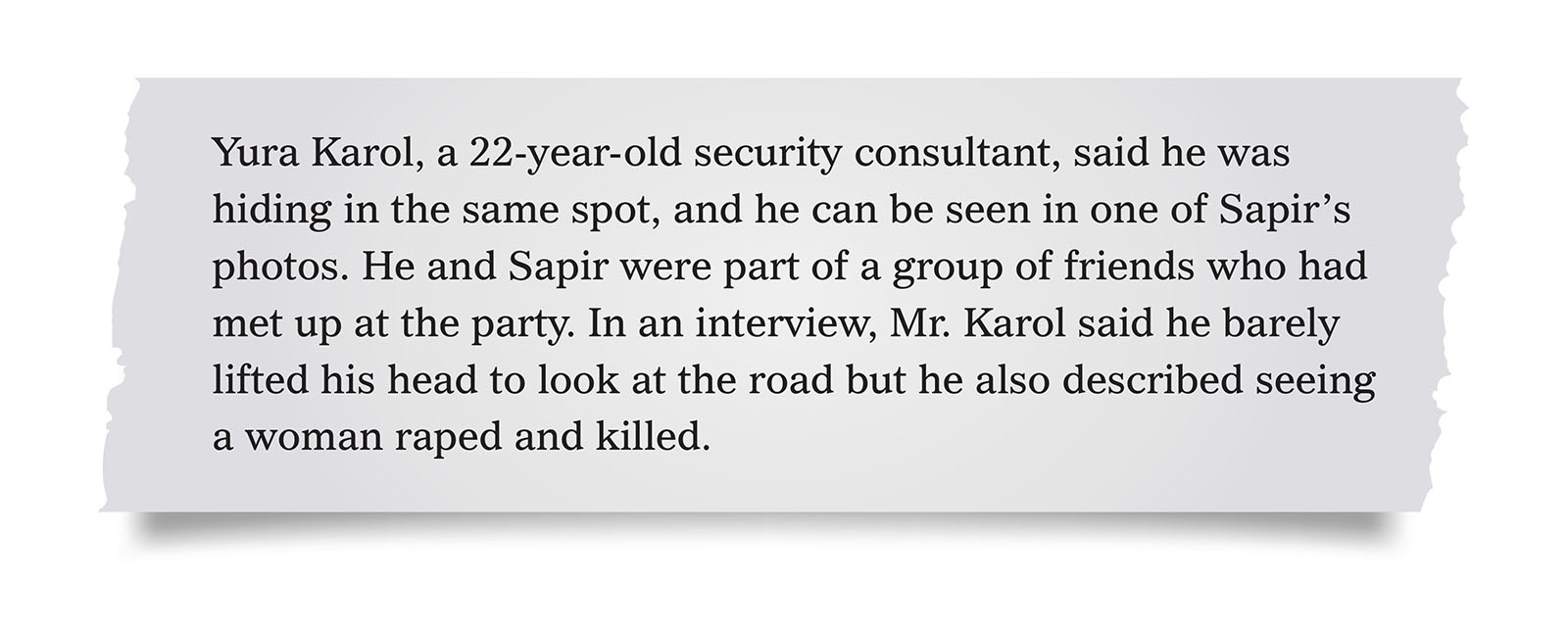
Response
When Sapir’s testimony was reported in Haaretz by Josh Breiner on November 8th, 2023, the person who was with her said he had not seen the rape. Haaretz reported: “Another witness who has recounted the incident to police was a man who was hiding behind the the eyewitness and didn’t see the rape. He said she told him at the time what she saw.” Since in ‘Screams Without Words’ he says he barely lifted his head, it seems likely that this is the same man, but that he has changed his story to corroborate that of Sapir. At the very least, we would expect The Times to ask after any change in his story and to scrutinize the credibility of this witness.
![Pull quote:
That same morning, along Route 232 but in a different location about a mile southwest of the party area, Raz Cohen — a young Israeli who had also attended the rave and had worked recently in the Democratic Republic of Congo training Congolese soldiers — said that he was hiding in a dried-up streambed. [...] Maybe 40 yards in front of him, he recalled, a white van pulled up and its doors flew open. He said he then saw five men, wearing civilian clothes, all carrying knives and one carrying a hammer, dragging a woman across the ground. She was young, naked and screaming. “They all gather around her,” Mr. Cohen said. “She’s standing up. They start raping her. I saw the men standing in a half circle around her. One penetrates her. She screams. I still remember her voice, screams without words.” “Then one of them raises a knife,” he said, “and they just slaughtered her.”](https://newyorkwarcrimes.com/media/pages/how-the-new-york-times-helps-israel-weaponize-rape-allegations-against-palestinians/a22c775296-1710178405/media-manufactures-consent-11.jpg)
Response
Raz Cohen is a “discharged IDF officer from the elite Maglan unit” and an Israeli special forces veteran who trains Congolese soldiers. Like Sapir, his testimony has changed dramatically over time. Raz Cohen has given multiple interviews to the media (CBC, Israeli Channel 12, PBS), some in which he mentions rape and others not. In a PBS interview on October 10th, he mentions necrophilia (which he omits in The Times interview).
But more significantly there he voices a need for “revenge” and says: “If Gaza was on the map, after this Gaza won’t continue to be on the map of Israel.” In the same interview, we find out that he has been called up as a reservist and feels a need to take part in the war on Gaza. This expressed genocidal desire for revenge, coupled with his shifting story, damage the credibility of Cohen’s account. Moreover, we might question why fighters equipped with guns and grenades (as we see on video from October 7) would use knives and a hammer.
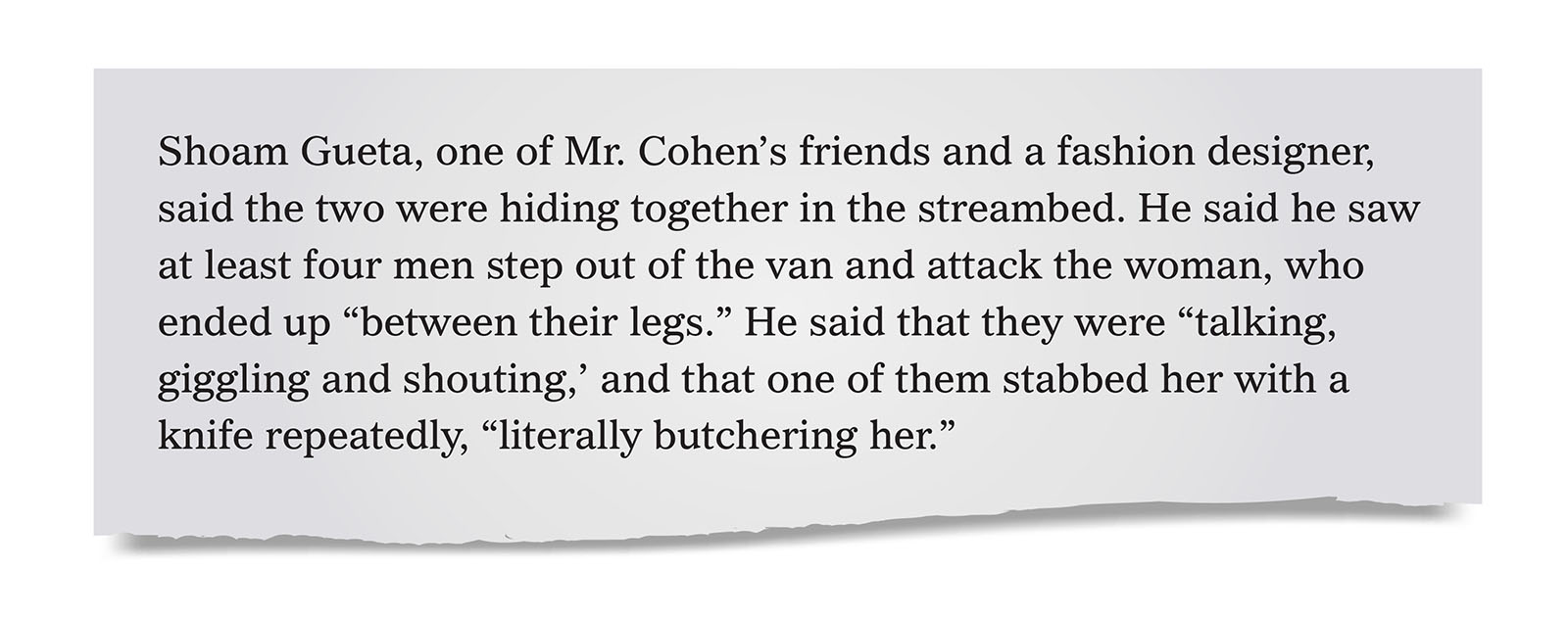
Response
Shoam Gueta says he saw an attack, and doesn’t specify rape. In an earlier interview with NBC News, he explicitly does not name rape. He says the victim was “cut with a knife.” His previous testimony does not include multiple stab wounds or laughter. (It is worth noting, again, that the use of knives to slaughter or butcher is a common Islamophobic trope that is supposed to recall the Muslim act of slitting the throat of sheep for sacrifice.)
Here’s his previous testimony from October 8th: “Shoam Gueta said he ran away from the barrage with a group of 20 people and hid in the bushes for nearly six hours as the onslaught unfolded around them. He used his mandatory military training experience to stay camouflaged and urged everyone in the group to remain silent and not to run away even when militants came within several feet. He saw Israelis gunned down as they tried to take cover and watched as a woman was cut with a knife. One friend hid in a portable toilet. ‘We saw terrorists killing people, burning cars, shouting everywhere,’ Gueta said. ‘If you just say something, if you make any noise, you’ll be murdered.’ Quietly, he said, Gueta called his mother to reassure he was safe despite the surrounding carnage.”
I.4 — Analyzing Testimony From Volunteer Medics (ZAKA) and an IDF Paramedic
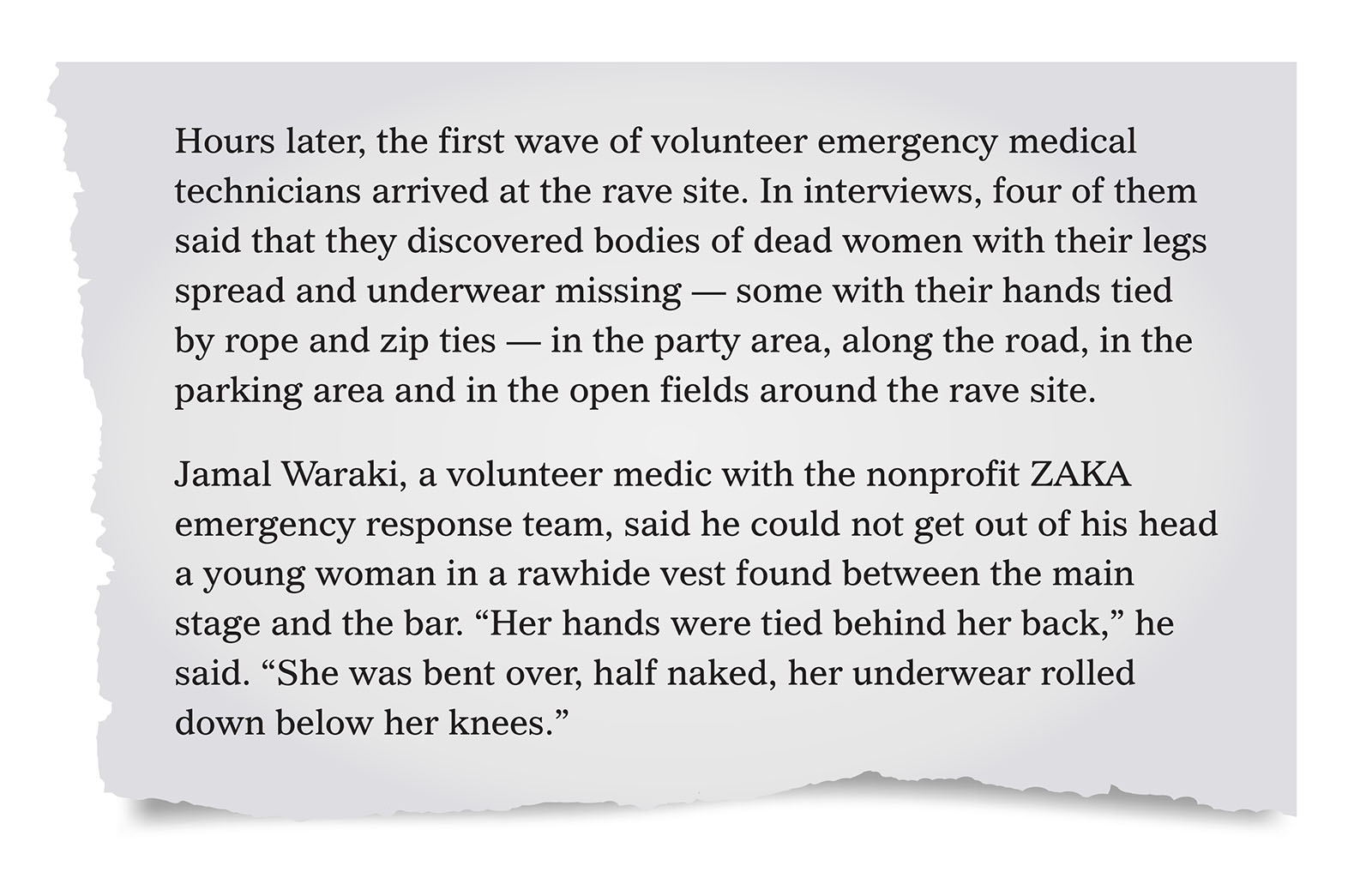
Response
It is important to understand that “volunteer medics” have been among the worst perpetrators of brutality propaganda in the aftermath of October 7. Eli Beer, the founder of United Hatzalah, went on a tour of the U.S. following October 7, in which he told stories of supposed Hamas atrocities to avid audiences of American zionists, raising over US$49 million for his efforts. One such story was that of the Jewish baby baked in an oven. This story has since been debunked, and United Hatzalah has claimed that the story was passed on by a volunteer whom they have since dismissed.
Another organization of volunteer responders is ZAKA. ZAKA, which is referred to in ‘Screams Without Words’ only as a nonprofit “emergency response team,” is described by Haaretz as “an ultra-Orthodox Jewish organization whose members retrieve bodies after terror attacks.” The testimonies of several ZAKA commanders and volunteers have already been debunked by both Haaretz and Libération in their corrective articles about October 7. Since The Times does not give us the names of the “four emergency medical technicians” with whom it spoke, it is not possible to address their individual credibility. To date, Yossi Landau, Simcha Greiniman, and Haim Otmezgin have all been discredited.
It is likely that The Times chose to speak to a Muslim Arab-Israeli member of ZAKA, Jamal Waraki, to avoid the criticisms that have arisen about its ultra-religious Jewish-Israeli members. However, Jamal Waraki works for both ZAKA and United Hatzalah, by his own admission; his main appearance, prior to The Times article, is in a propaganda video to promote Jewish-Arab unity on the Israeli government’s official Twitter account. Waraki’s relation to these organizations means that we should take his testimony with a grain of salt. At the least, his testimony cannot be considered credible without corroborating evidence. (Note that in his video appearance on Israel’s Twitter account, Waraki describes what he interprets as the aftermath of a different rape at a kibbutz, not the one in The Times article.)
‘Screams Without Words’ does cite Yossi Landau; he is quoted explaining his regret at having not taken photographs of the evidence he claims to have encountered, alongside a photograph of him gazing into the distance. The Times omits to discuss his lack of credibility, which has been amply demonstrated by Libération which points to several false testimonies that he has given. Landau is responsible for, among others, the story of the mass murder and burning of children tied together at Kibbutz Be’eri and a graphic account of the shooting of a non-existent pregnant woman, cutting of her abdomen, and kniving of her fetus at the same kibbutz. Both accounts have been disproven due to the absence of any bodies corresponding to the stories.
However, as a recent Mondoweiss article shows, there are structural problems that make ZAKA suspect beyond the false stories of atrocities spread by its individual members. This includes their financial corruption and attempt to raise funds through atrocity narratives; the accusations of rape and sexual assault that plagued their founder (Yehuda Meshi-Zahav) and over which he committed suicide in 2021; and the complicity of other members of ZAKA in defending him. In his ethnography of the organization, Israeli scholar Gideon Aran writes that, because of their Orthodox religious status, ZAKA members are exempt from military service, yet in their work they cooperate closely with the Israeli military, of whom they frequently express “envy and admiration.” ZAKA, Aran notes, is fiercely zionist and “represents a revolutionary ideal: Haredi macho.”
Even more damning is the lack of professional qualifications of ZAKA members to make assessments of sexual violence, and the lack of detail (age, location, time) in their testimonies, as well as their refusal to provide evidence. The vagueness of their testimonies means that often “it is impossible to either confirm or debunk them.” Moreover, as Mondoweiss points out, ZAKA has “a radical religious position against autopsies and forensic procedures,” and it is within their mandate “to work to prevent autopsies.” What has not been sufficiently examined is the role of ZAKA in the destruction of evidence and its tampering with crime scenes, that have meant that certain questions may never be answered. Specifically, who died from Hamas fighters’ gunshots or grenades, and who from IDF fire, shelling by tanks, or fire from IDF Apache helicopters? How were the cars fleeing from the Nova Music Festival burned (we know that IDF Apache helicopters fired on the site of the festival and couldn’t distinguish Israelis from Palestinian fighters)? What caused the total destruction of some of the kibbutzim houses (we know of at least two kibbutzim where houses were burnt-out and reduced to rubble by IDF tank shelling, but what of the rest)? And how did Ms. Abdush die (after all, The Times tells us that her family has yet to receive a death certificate)?
Videos of ZAKA members show them cleaning up the blood from houses in the kibbutzim. The Times notes that emergency response teams “said they had moved bodies, cut off zip ties and cleaned up scenes of carnage. Trying to be respectful to the dead, they inadvertently destroyed evidence.” It blames this destruction of evidence, not on their political interests but rather on their adherence to strict religious rules “that command deep respect for the dead.” It is hard not to see this as designed to back readers into a corner. If we criticize ZAKA’s destruction of evidence we are framed as critiquing Jewish burial practices and thus as potentially antisemitic (just as the article frames those who demand evidence of sexual assault as putting too much pressure on victims or failing to believe survivors, and hence anti-feminist).
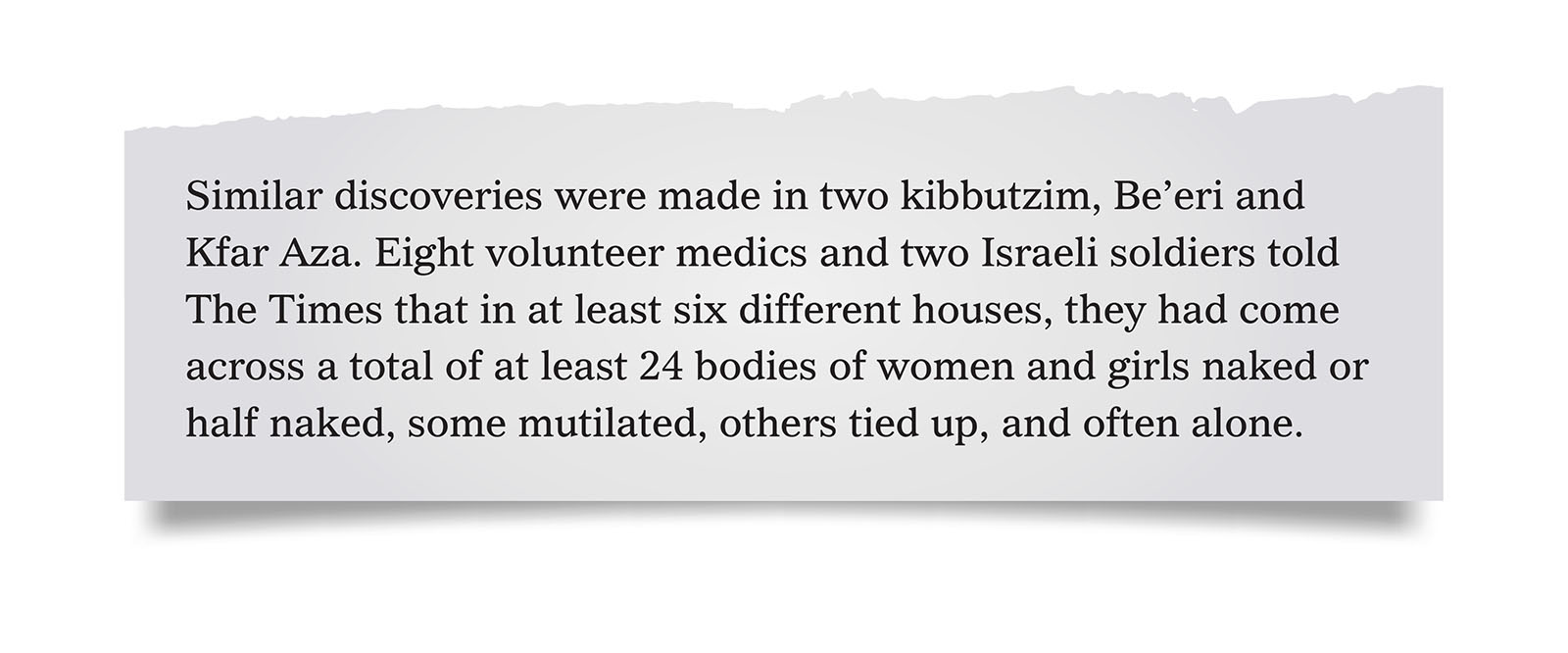
Response
The Times has previously published articles with detailed timelines of events at Kibbutz Be’eri and extensive interviews with survivors from Kfar Aza, in which there was no mention of rape. Rape was not part of the accounts that survivors gave. As the Kibbutzim are small and tight-knit communities where settlers are well known to each other, that widespread rape in a Kibbutz is not mentioned in the testimonies of several survivors renders it suspect. The evidence of The Times seems to rely on one IDF paramedic (see below) and the volunteer responders interviewed, the latter including ZAKA volunteers.
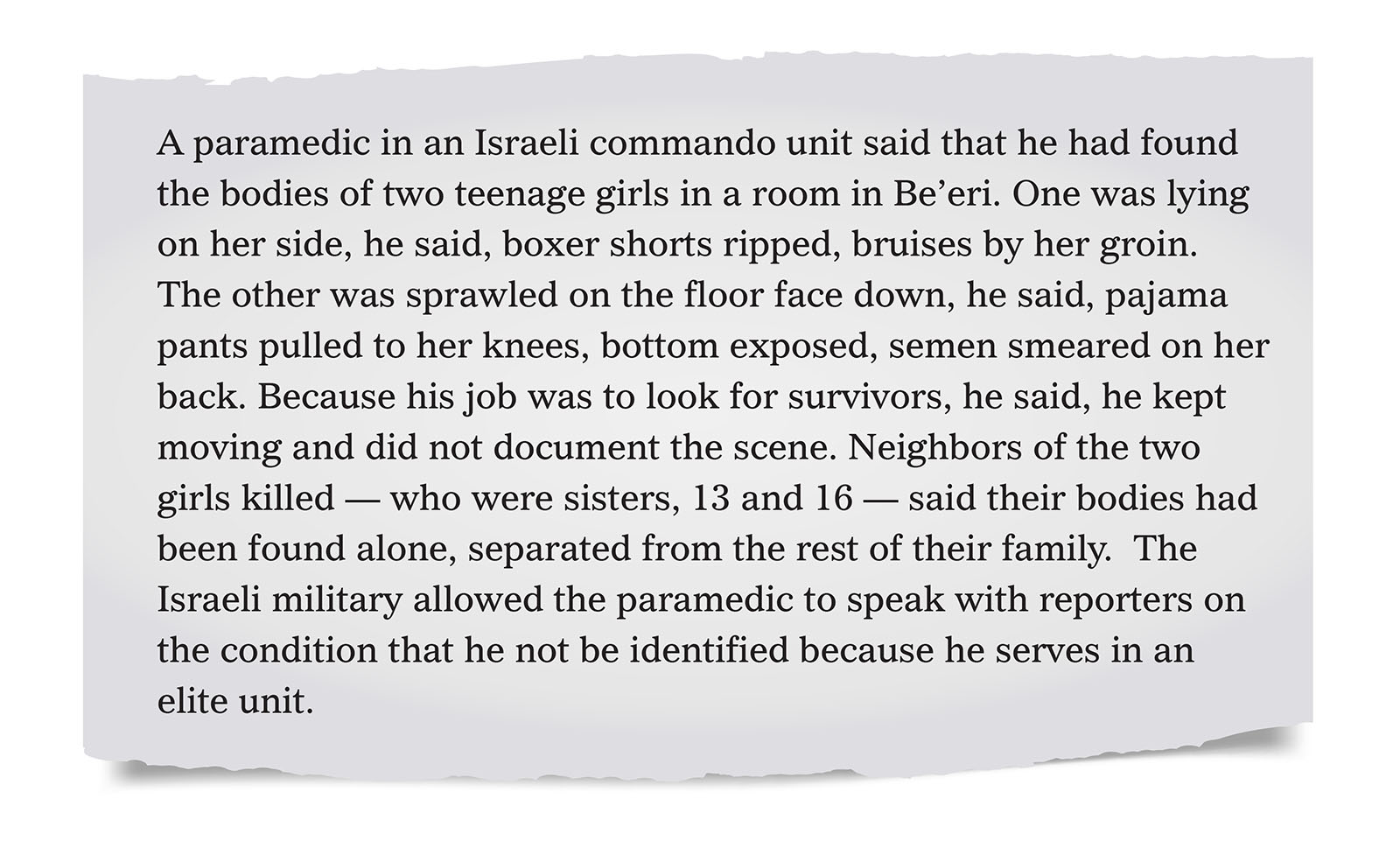
Response
According to the official Israeli records, there were two teenage sisters, 13 and 16, killed in Kibbutz Be’eri. But the girls were killed with their mother. Speaking to the BBC, their grandmother described how the bodies were found by a soldier “all cuddled together with Lianne [the mother] doing what a mother would do — holding her babies in her arms, trying to protect them at the end.” In a Mondoweiss article, it is shown that the elite commando unit, Unit 669, to which “G” belonged was not deployed to Kibbutz Be’eri on October 7, shedding doubt on his presence at Be’eri that day.
It should be noted that this paramedic provided the same witness account to the Indian news channel Republic TV, testifying with his back to the camera and identified as a chief sergeant in the commando unit 669. There he says this was at Kibbutz Nahal Oz. But there he adds: “one of my teammate saw a dog that was barking near a trash can, [. . .] he opened the trash can and pulled out of the garbage a baby, perhaps not even more than a year-old baby, that was multiple times stabbed all over his body and tossed in the garbage.” This testimony is demonstrably false. According to Israel’s National Insurance Institute, one baby under the age of 1 was killed on October 7: Mila Cohen, 10 months old, who was shot with her father at Kibbutz Be’eri. In their article debunking the story of beheaded babies on October 7, Libération found a second infant, Omer Kedem Siman Tov, 2 years and 3 months old, who died with his family in their burnt-out house in Kibbutz Nir Oz.
Note that this is the only testimony explicitly provided in The Times article about evidence of sexual violence at a Kibbutz, and it has been thoroughly discredited. Other testimonies about kibbutzim to which The Times refers are attributed to generic emergency responders who were likely ZAKA, and as above, such testimonies should not be considered reliable. Given that Hamas did not know that the rave (Nova Music Festival) was taking place in the field next to Kibbutz Reim on October 7 (the rave was scheduled to end on October 6), had they been planning to use rape or sexual violence as a weapon of war against civilians, they would have been targetting the kibbutzim. Yet we are presented with no credible evidence of sexual violence at the kibbutzim. Indeed, some of the survivors at the kibbutzim have testified that they were treated humanely by the Palestinian fighters who took them captive (for instance, Yasmin Porat). This sheds further doubt on the claim that systematic rape was intentionally used as a weapon of war by the Palestinian resistance on October 7.
I.5 — At the Shura Military Base: Two Witnesses, Neither of Whom Has the Medical or Forensic Training Required to Determine Rape
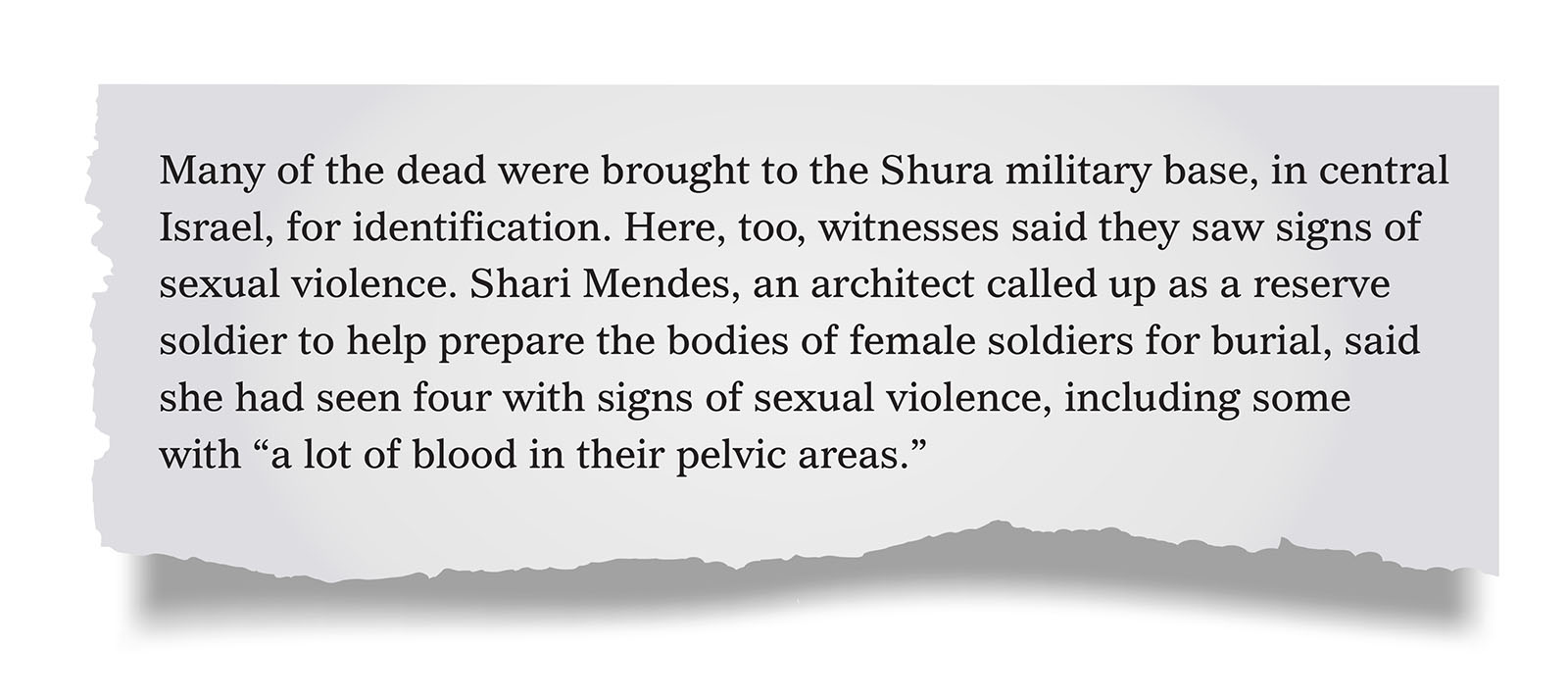
Response
Shari Mendes is a volunteer with the IDF Rabbinical Corps whose work is to prepare the bodies or remains of female soldiers for burial according to Jewish custom. The Times presents her as though she were an expert witness. However, while Ms. Mendes knows how to identify and prepare female bodies for burial, she is not trained in determining signs of sexual abuse or rape. She is neither a forensic examiner, nor does she have any medical training. In a previous interview with the Daily Mail on October 20, Ms. Mendes gave a more elaborate testimony, not only about four women, but of mass rape: “There is evidence of mass rape so brutal that they broke their victims’ pelvis — women, grandmothers, children.” And she added: “A baby was cut out of a pregnant woman and beheaded and then the mother was beheaded.” This story of a pregnant woman who was disemboweled and whose fetus was then beheaded is disproven by the National Insurance Institute records which show that, while there is a pregnant woman who was killed on October 7, she is a Bedouin woman who was shot in her car and her baby then died at the hospital after being delivered prematurely.
Ms. Mendes’ testimony at the UN on December 4, 2023 preempted some of what she says to The Times, but in that testimony it was clear that she was describing facial and genital “mutilation” due to gunshot wounds. She noted that the female soldiers she prepared for burial “were shot in several places in the body and then many times in the head [. . .] and it seems as if mutilation of these women’s faces was an objective.” Even more damning for the Time’s attempt to present Ms. Mendes as a credible witness of the postmortem signs of sexual violence, at the UN she doesn’t testify to having herself seen genital mutilation. Rather, Ms. Mendes says: “Our team commander saw several female soldiers who were shot in the crotch, intimate parts, vagina, or shot in a breast. This seemed to be a systematic genital mutilation of a group of victims.”

Response
The same two witnesses from Shura military base, whom The Times interviews, were already cited in a position paper published by Physicians for Human Rights Israel. In that paper, however, we are cautioned that they “are not professionally trained to determine whether rape had occurred.” In that paper, Maayan also testified to “broken legs and pelvises.”
I.6 — Lack of Physical Evidence and Corroborating Eyewitness Accounts
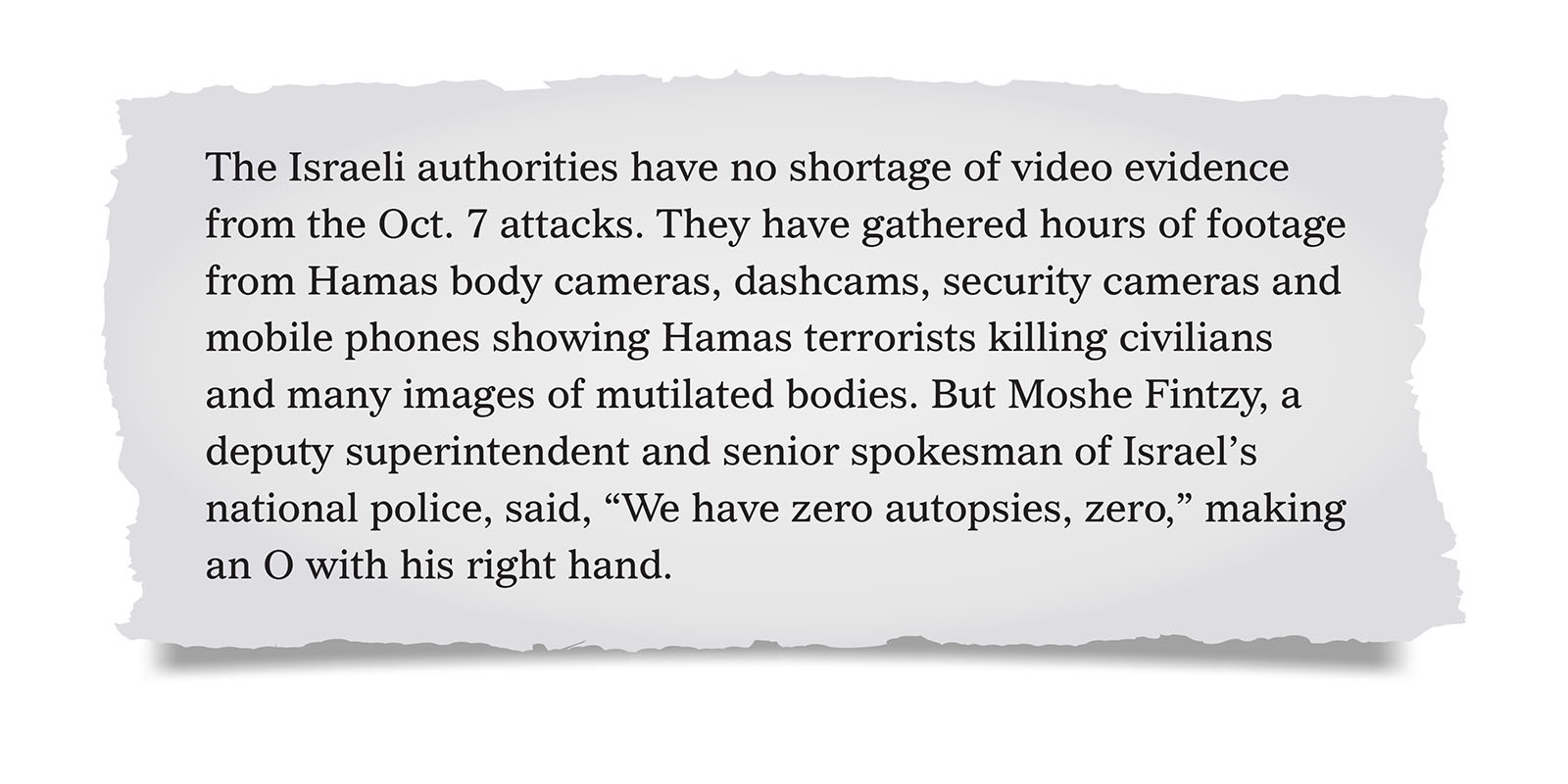
Response
“No shortage of video evidence” makes it sounds as if Israeli authorities have proof of sexual assault on film. Yet, these videos are of “mutilated bodies,” where the possible signs of sexual assault or mutilation are interpreted from the postmortem condition and disposition of those bodies. In fact, there is a lack of corroborating videos that show sexual assault, despite the magnitude of footage.
Owen Jones (of The Guardian) — who saw the compiled 43 minute montage by Israel of October 7 shown to select international journalists and diplomatic missions — notes that this was presumably the best evidence Israel had of Hamas “atrocities.” He explains that Israel had access to CCTV and dashcam footage, and so would not have had to rely simply on Hamas telegram channels and mobile phone videos from fighters or Israelis. It is worth noting that Jones said he did not see conclusive evidence of rape in the Israeli compilation.
While as feminists we agree that “[i]n cases of widespread sexual violence during a war, it is not unusual to have limited forensic evidence, experts said”, this case differs. Israel has the capacity and infrastructure to carry out forensic examinations (as it has done for DNA analysis of remains, revealing that 200 of the initial 1400 dead were in fact Palestinians whose bodies were charred beyond recognition).11 This is especially the case given that the window of active fighting was relatively small and Israeli police/military had unimpeded access to bodies in the aftermath. The problem is not only that no forensic evidence of sexual assault was collected at all. More damning is that we are asked to lend credibility to several witnesses interviewed by The Times — ”volunteer medics” from ZAKA, soldiers, reservists at the Shura morgue — all of whom claim that they saw bodies with what they suspected, at the time, were signs of sexual violence, yet none of whom asked for forensic examination nor autopsy of the bodies in question. While not all bodies could be examined, it would have been logical to examine those where signs of sexual abuse were claimed to have been noted early on — as in the case of Gal Abdush for instance. This engineered incompetence serves to obscure accountability.
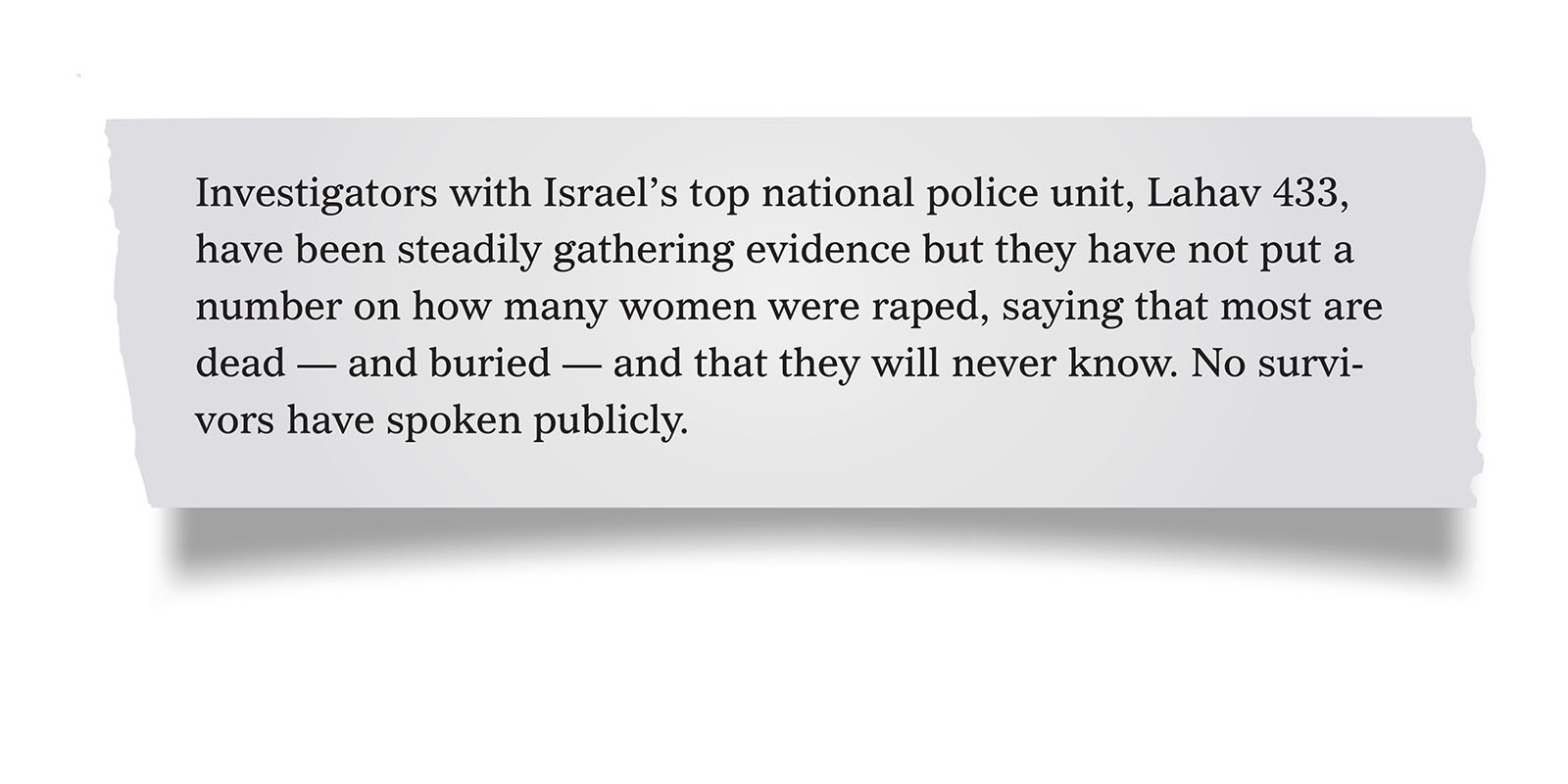
Response
The magnitude and scale matters for the claim of systematic and planned mass rape. Yet we have no sense of scale here. Indeed, the vagueness of the numbers turns out to be a problem not of too many bodies to count, which is what The Times attempts to portray, but of there being too few or no documented cases.
On January 4, 2024, Haaretz published an article on the difficulty that the Israeli police investigators were having “finding living victims of or witnesses to sexual assault committed by Hamas on October 7.” It explained that this was “due to the fact that many of the victims were killed that day, taken hostage or are in a state of psychological distress and unable to testify.” The aim of the article was to appeal “to the public to encourage anyone with information to contact [the police] and give a statement.” This public call by Israeli police puts the lie to many of the claims in The Times article of December 28.
After all, The Times’ claim is not that there were individual and isolated acts of sexual violence, but that there was a “pattern.” While The Times claims that “very quickly after Oct. 7 [Israeli officials] began collecting evidence of atrocities,” it is clear that they have not been able to collect reliable corroborating testimonies of sexual assault. Indeed, in cases where rape is used as a “weapon of war,” it is systematic, planned and intentional, so that multiple testimonies and eyewitnesses exist to corroborate one another.
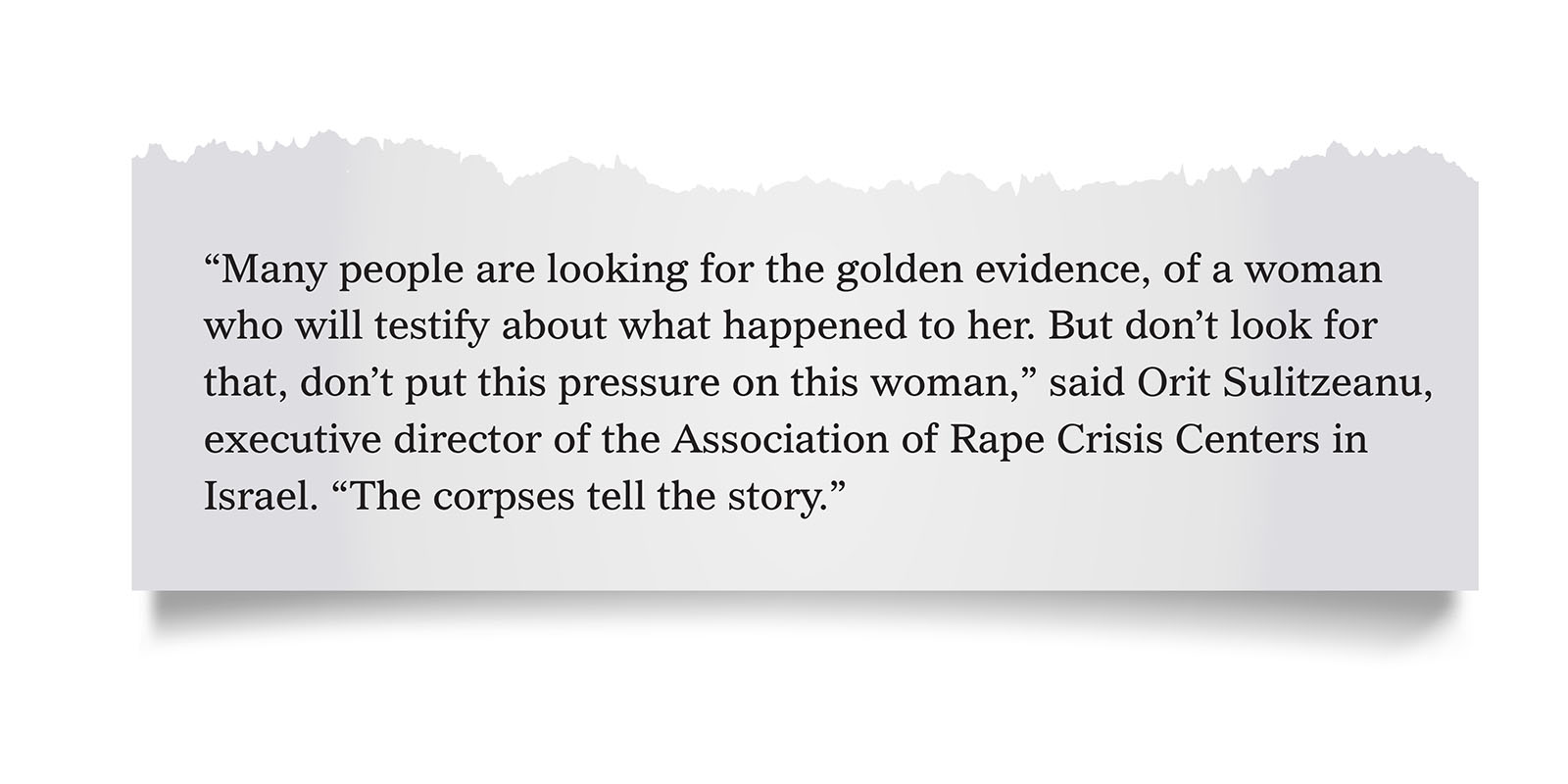
Response
Yet, this runs counter to the call that Israeli police investigators just issued to “living witnesses and victims” to come forward and give a statement to police. This is because it is by now evident that Israel has not been able to collect evidence from corpses, or was not willing to do so. The problem here is not with the silence of survivors of sexual violence, but with the weaponization of that potential silence to dehumanize the Palestinian people in Gaza and to justify genocide. Israel is currently weaponizing the possibility that there are silent victims unwilling to come forward, or that all victims are dead and thus unable to speak, in order to preempt the demand for evidence that there was a pattern of premediated and widescale rape involved on October 7.
II. Every Accusation is a Confession
“Sexual violence is central to the larger structure of colonial power, its racialized machinery of domination, and its logic of elimination.”
—Shalhoub-Kevorkian, Ihmoud and Dahir-Nashif
At the same time as Israeli and western media launch unfounded accusations of systematic sexual violence against the Palestinian resistance, Israel continues to systematically enact sexual violence against Palestinians, as it has done now for over 75 years. This violence, which is enabled by the broader structural violence of the occupation, is pervasive and well-evidenced.
Below, we offer just some examples of this violence.
II.1 — Rape and Sexual Abuse During Israeli Military Aggression
Evidence of rape and sexual assault committed by Israel during military aggressions date back to the Nakba of 1948, in which Israel destroyed over 600 Palestinian villages, murdered over 20,000 Palestinians and expelled over 750,000 Palestinians from their homes. Historian Ilan Pappé details several instances during the Nakba in which mass rape was enacted by Israeli soldiers. These instances of mass rape were reported by Israeli soldiers to their own high command within a few days of the events. One such instance was the Massacre of Dawaymeh on October 28 1948, of which Pappé writes, “The Jewish soldiers who took part in the massacre also reported horrific scenes: babies whose skulls were cracked open, women raped or burned alive in houses, and men stabbed to death.”12 Pappé details extensive Israeli documentation of rape committed by its own soldiers both during the Nakba and in its immediate aftermath. For example, Israeli prime-minister at the time David Ben-Gurion made note of “rape cases” every few days in his personal diary. One such entry described “a case in Acre where soldiers wanted to rape a girl. They killed the father and wounded the mother, and the officers covered for them. At least one soldier raped the girl.”13
Israeli militarism has continued to call on discourses and practices of sexual violence, with mounting ferocity. Accompanying Israel’s 2014 assault on Gaza which killed 2,251 civilians, left 500,000 displaced and injured 11,231 were images demanding and celebrating sexual violence, such as the portrayal of Gaza as a half-naked woman in a niqab with a caption calling on Israeli Prime Minister Netanyahu to rape her, circulated widely on Israeli social media. Public banners sponsored by the City Council of Or Yehuda declared, “Israel Defense Forces soldiers, Or Yehuda’s residents are with you! Pound ‘their mothers’ and return safely to your own mother!”14 At the same time, incidents of Israeli female soldiers posting photographs of themselves posing besides blindfolded and handcuffed Palestinian male prisoners, such as those posted by Eden Abergil, demonstrate the ways in which Israel’s sexual and gendered violence is also perpetrated against Palestinian men.
Today, we have evidence that Israel has been using sexual violence, not only against Palestinians held in Israeli prisons (see below) but against Palestinian civilians in Gaza. In a chilling video first published on social media on October 31 and verified by Amnesty International’s Crisis Evidence Lab, nine Palestinian men are pictured stripped naked or half-naked, blindfolded and handcuffed, surrounded by at least 12 armed Israeli soldiers, one of whom kicks a detainee in the head. Similar videos of Palestinian men of all ages — including elderly and disabled individuals, and children — forced to strip, blindfolded and forced into humiliating and degrading positions en masse have circulated in the weeks following.
II.2 — Sexual Abuse of Prisoners
On December 21, the Guardian reported that over 8,000 Palestinians were being held in Israeli prisons, many of them detained after October 7. Thousands of these prisoners — and more than 80% of those detained since October 7 — are subject to so-called ‘administrative detention’: indefinite, arbitrary imprisonment. Amnesty International has found that Israel has systematically used administrative detention as a tool to persecute Palestinians. This persecution involves forms of routine sexual harassment and abuse. According to Addameer, a Palestinian Non-Governmental Organization based in the West Bank, “the majority of Palestinian women prisoners are subjected to some form of psychological torture and ill-treatment throughout the process of their arrest and detention, including various forms of sexual violence that occur such as beatings, insults, threats, body searches, and sexually explicit harassment.” During an interview with Al Jazeera Arabic TV, Ruqayah Amra, one of the Palestinians released as part of the November 2023 prisoner exchange deal, explained that female Palestinian prisoners were subjected to threats of sexual assault and naked beatings. In a December 1 interview with Democracy Now, freed Palestinian journalist Baraah Abo Ramouz explained that “the situation in the prisons is devastating. The prisoners are abused. They are being constantly beaten. They’re being sexually assaulted. They are being raped. I’m not exaggerating. The prisoners are being raped.”
In an interview published by Middle East Eye after her release from Israeli prison in November 2023 Palestinian journalist and writer Lama Khater stated that she was treated “with great brutality and extreme violence” and an Israeli intelligence officer threatened her with rape. “I was handcuffed and blindfolded,” she recounts “I was explicitly threatened with rape. I was even told they had 20 soldiers around me. It was clear the goal was to intimidate me.”5 According to Khater threats of rape were used against other female prisoners, and female prisoners — including women kidnapped from Northern Gaza in the days before the truce- were subjected to strip searches. Amnesty International has similarly reported on the use of rape threats and forced nudity against Palestinian prisoners, and the confiscation of sanitary pads from Palestinian women prisoners.
In a 2015 Israeli investigation conducted by Bar Ilan University, it was found that the sexual abuse and torture of Palestinian men and boys in Israeli prisons is “systemic.” The study based its results on thousands of testimonies collected by the Public Committee Against Torture in Israel (PCATI). Examples of sexual abuse suffered by the prisoners included forced nudity (often for extended periods of time), verbal sexual harassment including threats of rape, touching or kicking the genitals, being urinated on while handcuffed, simulated rape and actual rape with blunt objects. Victims of sexual torture and abuse described in the study included minors, with an age range from 15–43 years.
Many children are among those imprisoned and subjected to sexual violence. According to a 2023 report by Save the Children, Palestinian children are the only children systematically prosecuted in military courts, and between 700–1,000 Palestinian children are imprisoned by Israel each year (many for alleged stone throwing, which can carry a prison sentence of up to 20 years). While imprisoned, “the majority of children experienced appalling levels of physical and emotional abuse.” During their detention, over 86% of Palestinian children are routinely beaten, 60% are subjected to solitary confinement, and 69% are strip searched. Addameer reports that sexual threats and assaults are common against child prisoners, and include “the form of grabbing a child’s testicles and threats of rape or sodomy with an object.” In 2021 the rape and sexual torture of a 15-year-old Palestinian boy at a Jerusalem detention cility was reported by Defense For Children International Palestine (DCIP). The boy had been told that if he reported the rape he would face further sexual torture. On October 25, 2021 DCIP was listed as a terrorist organization by the Israeli government in response to these allegations.
II.3 — Sexual Abuse and Harassment at Checkpoints, During Raids and in Airports
In their study of the experiences of women visiting loved ones held in occupation prisons, Al Issa and Beck (2021) found that 19 out of the 20 Palestinian women they interviewed had experienced “multiple instances of sexual abuse.” Each of the 19 women had experienced “physical touching and forced nudity, which was often accompanied by humiliating or derogatory remarks.”15 All but two of the women stayed silent about the abuse, out of fear of jeopardizing future visitation rights. This points to the dramatically uneven power dynamics shaping the capacity of Palestinians to speak out about their sexual abuse at the hands of the Israeli police and military.
Despite this, instances of systematic sexual abuse against Palestinians are well documented. This includes sexual abuse at Israeli checkpoints, which govern the movement of Palestinians throughout the West Bank, and sexual abuse during Israeli military raids of Palestinian homes (a common Israeli device of terror and collective punishment). For example, in 2023 Israeli soldiers forced five Palestinian women to strip naked in front of their children during a night raid on their homes. When interviewed about the incident Palestinian human rights activist Hisham Shrabati explained, “This is not an exceptional incident, and it is not the first case of this kind that I document in Hebron . . . There are similar cases happening regularly, as the occupation forces raid Palestinian homes in Hebron on a daily basis.”
Multiple instances of sexual violence committed against Palestinian women by Israeli soldiers at checkpoints have also been reported in Haaretz and by B’Tselem, such as the demand for sexual “favors,” i.e. the enacting of physical sexual abuse in order to be allowed to pass through a checkpoint. As an indicator of how structurally endemic such abuse is, in 2022 both Haaretz and the Times of Israel reported that a senior Shin Bet officer accused of rape and of ordering a “genital examination” of a Palestinian woman at an Israeli checkpoint had been promoted to a high position within Shin Bet, despite advice that he be fired.
III. Conclusion and Summary
Our case against the allegation that systematic rape was committed by the Palestinian resistance on October 7 is as follows:
First, All the rape testimonies are centred on the rave (Nova music festival), where there were thousands of people — and even after evacuation, several hundred remained. There are four testimonies in The Times article, at two locations at the festival site. However, according to Haaretz, Hamas likely did not have advance knowledge that the rave was still taking place on Saturday. (It was supposed to end on Friday and the organizers asked, a few days before, to extend it till Saturday.) It appears that fighters were surprised to find the rave taking place in the field near Kibbutz Reim. So planning mass rape at the festival was not even a possibility.
This means that if there was a plan of systematic rape, it would have targetted the kibbutzim. Yet we have shown through detailed analysis that there is no credible evidence of sexual violence at the kibbutzim. This is telling given that fighters spent a long time entrenched with the hostages in kibbutzim houses, trying to delay the retaking of the Gaza Envelope (in some cases into Sunday).
Second, there are only four testimonies featured in ‘Screams Without Words.’ This does not constitute a “pattern,” and each of the four testimonies has significant problems that affects the credibility of the witness. Even when we include the “volunteer medics” and military personnel, we still have only a handful of witnesses — many of whom are interpreting the condition and disposition of a body postmortem, with no professional expertise or medical training.
Third, Israel is relying heavily on recorded visual “evidence,” photographic or video, that has been circulated online. These visual recordings present hermeneutical challenges. While conclusions of rape are often circulated as self-evident, specific knowledge, care and corroborating sources are needed to interpret manner of death or injury from such sources; these are only one among many sets of possibilities they present. It is also important to pay attention to their limitations, for context and history, cleared villages and occupied land, remain outside the frame. Indeed, as Ariella Aïsha Azoulay notes, “images do not have an innate truth; they live in community with or against those who are involved in them.” Outside the frame of the images in which Israel asks to see Palestinian violence is the very “fact that images of violence targeting Israelis are being weaponized as decisive proof for the legitimacy of Israel’s response,” for the genocide of Palestinians.
Fourth, the charge that rape has been used as a “weapon of war” requires both systematicity and intentionality. Israel has relied on two confessions to support its case that rape was a planned and intentional part of the October 7 operation. Yet, given the interrogation practices of Israel’s Shin Bet, such confessions would have been obtained under torture and cannot be relied on. In a public statement released on December 31, 2023, Hamas political bureau member Dr. Bassem Naim stated that Hamas “categorically deny” allegations that their fighters had engaged in the use of rape and sexual violence. This is not the first time that Hamas has denied the allegations and welcomed an independent international investigation.
Fifth, the purported universality of rape as a “weapon of war” is employed to justify the claim that it was used systematically and deliberately on October 7 by Hamas. However, several prominent Israeli sources in the campaign to accuse Palestinians of rape on October 7 have said that Israeli authorities were not prepared to conduct forensic examinations, use rape-kits, or collect evidence of rape, because they did not expect it.16 This is because Hamas, and the Palestinian resistance more generally, had never committed rape in past attacks. This historical matter of fact should contextualize and undermine universalizations regarding rape as a weapon of war.
More troubling, the argument that rape is always a weapon of war normalizes rape as a quotidian part of military action. It is argued: why would Hamas, and by extension Palestinian fighters, be any different from other military groups — or the IDF? This argument feeds into attempts to render both sides equivalent, removing the ability to make value judgements. But only one side benefits from such equivalence, since this equivalence renders ordinary — and beneath outrage — the actions of those who wield power; it renders normal the colonial violence that structures the status quo. In other words, it normalizes Israeli sexual violence against Palestinians. Yet in the case of Palestinian fighters, as we saw, the Israeli charge of rape is compounded with allegations of mutilation, sadism, and beheading. This serves to put Palestinian fighters beyond the pale — to cast them as not only rapists but inhuman monsters. It is for this reason that the testimonies Israel promotes are exorbitant in their cruelty, with gruesome details and Islamophobic stereotypes. It is for this reason that the charge of systematic and brutal rape is a tool used not only to demonize the Palestinian resistance, but to dehumanize Palestinian men in general. By framing Palestinian resistance, not as an anticolonial liberation movement but through the trope of the terrorist-rapist, the right of Palestinians to armed resistance against occupation under international law is also erased.17 The urgency with which the narrative of the terrorist-rapist is being employed correlates to the timing of intensification in Israel’s genocide in Gaza. The timing of this campaign may also have to do with Israel’s anxieties over losing the media war and its attempt to counter the humanization of Palestinian men that has taken place through the proximity that the public feels to their stories, as they film and share their own images online — contrasting starkly with racist depictions in the hegemonic media.
Far from being a “newspaper of record,” The New York Times has demonstrated once again its complicity with power. The paper’s editorial guidelines demand that reporters “preserve a professional detachment, free of any whiff of bias,” yet the newspaper has consistently violated its own as well as internationally recognized journalistic standards of objectivity. As this report has demonstrated, The New York Times has been a leading actor in manufacturing consent for genocide in Gaza.
IV. A Final Note
While this analysis has aimed to deconstruct Israeli propaganda, we acknowledge that for many Palestinians this work does not need to be done. Dr. Refaat Alareer (above), assassinated in Gaza by Israel on the 6th December, 2023, wrote in 2010:
“It is no wonder when Gazans remember Israel as the Israel that bombed, destroyed and/or bulldozed Gaza bridges, schools, universities, thousands of houses, mosques, farms and fields, trees and greenhouses. Israel, for Gazans, killed thousands and inflicted injury, pain, deprivation, poverty, and disability on tens and hundreds of thousands. No matter how many clips they post, no matter how many pictures they claim to use as evidence, no matter how many millions of dollars they spend for the cover up, and no matter how many arrogant spokespersons, who by the way have a habit of never answering any question, appear on TV, Israel swots up on its homework to be done in Gaza. It spends billions of dollars on propaganda and thousands of hours of meetings and preparations. However, In Gaza and only by Gaza, Israel’s true face is revealed in a blink on an eye. There is no homework done well for Israel in Gaza.”
No amount of propaganda will erase the memory of Palestinians living through Israel’s current genocide, just as no amount of propaganda will erase Palestinians’ collective historical memory of Israeli violence. In the propaganda war, the truth of this memory will ultimately win out.
Notes
1
Angela Davis, Women, Race & Class (New York: Random House, 1981), 154.
2
Anthony Collins, “Screams without words and claims without context,” YouTube (January 1, 2024).
3
Mohja Kahf, Western Representations of the Muslim Woman: From Termagant to Odalisque (University of Texas Press, 1999), 144.
4
Edward Said, Orientalism (New York: Vintage Press, 1978), 167.
5
Sahar Ghumkhor, The Political Psychology of the Veil: The Impossible Body, (London: Palgrave Macmillan, 2020).
6
Jasbir K. Puar, Terrorist Assemblages: Homonationalism in Queer Times (Durham: Duke University Press, 2007), 147.
7
Frantz Fanon, The Wretched of the Earth, trans. Constance Farrington (New York: Grove Press, 1963), 6.
8
Noam Chomsky and Edward Herman, Manufacturing Consent: The Political Economy of Mass Media (New York: Pantheon Books, 1988), 1.
9
Many tallies of Gaza’s casualties normalize this logic by counting all adult Palestinian men, between 18 and 60, as potential combatants. Marc Lynch and Sarah Parkinson, “A Closer Look at the Gaza Casualty Data,” Good Authority, 14 Dec. 2023
10
According to a police source, the investigation indicates that an IDF combat helicopter that arrived to the scene and fired at terrorists there apparently also hit some festival participants.” Josh Breiner, “Israeli Security Establishment: Hamas Likely Didn’t Have Advance Knowledge of Nova Festival,” Haaretz, Nov. 18, 2023.
11
This raises the issue of why Israel counted them as Israelis, given that bodies burnt to this extreme were more likely the outcome of Apache helicopter fire or tank shelling and hence the responsibility of the IDF. As military analyst Scott Ritter has pointed out, the lack of autopsies is also a way to avoid accountability for deaths that may have been from “friendly fire.”
12
Ilan Pappe, The Ethnic Cleansing of Palestine (London: Oneworld Publications, 2007) 275–6.
13
Ibid., 292.
14
Rabab Abdulhadi, “Israeli Settler Colonialism in Context: Celebrating (Palestinian) Death and Normalizing Gender and Sexual Violence,” Feminist Studies, 45, 2–3 (2019) 541.
15
Ferdoos Abed-Rabo Al Issa and Elizabeth Beck, “Sexual Violence as a War Weapon in Conflict Zones: Palestinian Women’s Experience Visiting Loved Ones in Prisons and Jails,” Affilia 36, no. 2 (2020), 177.
16
Hadas Giv, a co-author of the position paper of Physicians for Human Rights Israel (cited above), noted this in an interview with Isaac Chotiner. “How Hamas used sexual violence on October 7th,” The New Yorker, 10 December, 2023. This was also stated by Cochav Elkayam-Levy, the head of the Israeli Civil Commission investigating sexual violence on October 7.
17
See article 1(4) of the Additional Protocol I of the Geneva Convention (1977), UN General Assembly Resolution 2625 (1970), United Nations (UN) General Assembly Resolution 37/43 (1982), and the UN General Assembly Resolution 45/130 (1990). See also this statement from the National Lawyers Guild.


